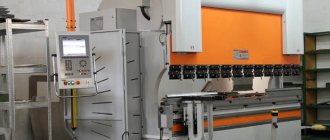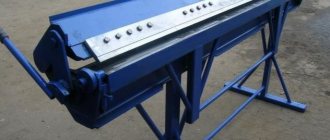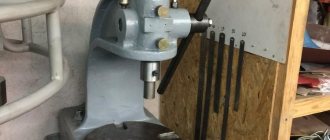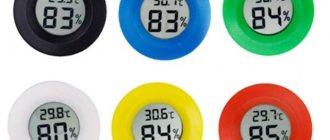Without exaggeration, the hydraulic press is one of the 100 greatest inventions of mankind. The appearance of such a machine was facilitated by Pascal’s law, which was formulated back in 1653. The first such device was patented by the English inventor, one of the founders of hydraulic engineering, Joseph Bramah, in 1795.
At first, the hydraulic press was used to lift heavy loads and obtain natural oils and juices, as well as form hay bales. Over time, the design of hydraulic presses has changed and modernized. Since 1820, the unit began to be used in the metalworking industry for pressing pipes. 55 years later, a stamp and a movable traverse appeared in the design, which contributed to the introduction of the technology into the military industry.
Thanks to the saving of metal, simplicity of design, speed of production and optimal performance, the press is widely used in the production of automobiles, marine vessels, aviation and agricultural equipment.
Varieties and characteristics
Main characteristics of a hydraulic press (parameters of each model are shown in the drawing):
- compression force (tons);
- handle force (Newtons);
- operating speed (millimeters per second);
- working stroke (centimeters);
- oil pressure in the hydraulic drive (Megapascal);
- drive power (kilowatts);
- dimensions and weight (millimeters and kilograms).
This range of parameters defines two types of drives:
- pump drive – does not use the principle of energy storage;
- pump-flywheel and pump-accumulator drives - use energy accumulation during periods between working strokes.
The service station uses different types of hydraulic presses: tabletop, vertical, electrohydraulic and pneumohydraulic (capable of developing a force of up to 100 tons).
According to the method of functioning, hydraulic presses are divided into two groups:
- automatic;
- manual.
Manufacturers make units with closed and open frames for working with elements of non-standard shapes. Based on the dimensions, there are desktop and floor-standing models. Depending on the bed, there are 2 types of presses: rack-mount and column-mounted. By type, two categories of devices can be distinguished: universal and specialized (special purpose).
Information about the manufacturer of the single-column hydraulic press P6324
The manufacturer and main developer of the P6324 hydraulic press is the Orenburg hydraulic press plant Gidropress, founded in 1953.
The first hydraulic press for plastics processing, PA-474, was adopted by the state commission on September 23, 1953, this day is considered by press builders to be their birthday.
The manufacturer of the P6324 press is also the Tambov Process Equipment Plant.
Currently, the P6324 press is also produced by PRESSMASH SO LLC, Moscow. Website address: https://sopressmash.ru
Machines produced by the Orenburg hydraulic press plant GidroPress
- DG2432
- hydraulic frame press for plastics 1600 kN - DG2434
- hydraulic frame press for plastics 2500 kN - DG2436
- hydraulic frame press for plastics 4000 kN - DE2426
- hydraulic frame press for plastics 400 kN - DE2428
- hydraulic frame press for plastics 630 kN - DE2430
- hydraulic frame press for plastics 1000 kN - P6320
- hydraulic single-column C-shaped press with correct pressing 100 kN - P6320B
- single-column C-shaped hydraulic press, properly press-fitted, 100 kN - P6324
- hydraulic single-column C-shaped press with correct pressing 250 kN - P6324B
- single-column C-shaped hydraulic press with correct pressing 250 kN - P6326
- hydraulic single-column C-shaped press with correct pressing 400 kN - P6328
- single-column C-shaped hydraulic press with correct pressing 630 kN - P6328B
- single-column C-shaped hydraulic press, properly pressed, 630 kN - P6330
- single-column C-shaped hydraulic press with correct pressing 1000 kN - P6334
- single-column C-shaped hydraulic press with correct pressing 2500 kN - PD476
- hydraulic frame press for plastics 1600 kN
Application and practical features of work
The wide range of power and design solutions of hydraulic presses allows them to be used for a variety of tasks: stamping, trimming, flanging, embossing, pressing, stitching, calibrating, bending, forging and even lamination.
Areas of use:
- industrial production;
- waste disposal (horizontal installations);
- repair of vehicles and special equipment;
- locksmith work.
Using such equipment, you can work with pipes and metal profiles, plastic and ceramic products, carbon and carbon-graphite electrodes, as well as produce rubber parts, cables, electrical insulating materials, various finishing and building boards and much more.
Features of various models:
- glycerin pressure gauges are characterized by increased accuracy, durability, vibration suppression and a wide measurement range;
- the winch mechanism is indispensable for adjusting the working surface;
- automatic rod return function significantly improves productivity;
- the safety valve will prevent excess pressure;
- chrome plated rod eliminates corrosion processes;
- modern units are equipped with progressive CNC.
In addition, the designs do not include various modules that protect against overloads, which has a positive effect on the price of pressing equipment. It is also noteworthy that the position of the moving table has no effect on the pressure value.
Recommendations for use
In order not to encounter a situation where a manual hydraulic press requires repair after a short period of use, certain rules should be followed. First of all, it is necessary to pay attention to the correct installation of the press, focusing on the information provided in the accompanying document by the manufacturer.
Recommendations for operating a manual hydraulic press, which will avoid its frequent breakdowns and, accordingly, the need for repairs, are as follows:
- checking the working fluid level (this affects how much pressure the hydraulic cylinder can create);
- regular lubrication of moving and rubbing parts;
- checking the condition of sealing elements, which may lose their elasticity over time;
- checking the reliability of fastening the part during its processing.
Typical faults and methods for their elimination
When moving a manual hydraulic press, it is necessary to monitor the level at which the work table is located. This parameter is checked every time the pressing equipment is started.
Advantages
Among the advantages of hydraulic presses, the main ones are:
- significant gain;
- the ability to implement different technological processes;
- high design reliability and safety;
- ease of work under a given mode;
- ease of control and low noise level;
- the ability to connect any hydraulic equipment to the drive (buckets, jackhammers, grippers, circular saws);
- speed and practicality.
Before purchasing such equipment, you should pay attention to the material of the frame structure, the quality of the seams, the presence of a return piston, the serviceability and reliability of the pressure gauge and hydraulic system, and also check the possibility of adjusting the height of the working area.
Hydraulic presses
A hydraulic press is a pressure pressing machine that uses hydraulic pressure, or fluid pressure, through a cylinder to apply force to an object.
Hydraulic presses are based on Pascal's principle, according to which pressure in a closed system will act with equal force in all areas.
As the most common and most efficient type of industrial press, hydraulic presses have high lifting or compressive force that cannot be achieved with pneumatic or mechanical presses.
Application of hydraulic presses
Hydraulic presses are manufactured to enable manufacturers to stamp metal material onto a variety of finished parts. They can also perform other metal forming processes such as bonding, forging, stamping, cutting, forming, deep drawing and blanking.
Some of the industries that rely most on hydraulic press services include: Automotive, Packaging, Home Appliances (e.g. Microwave Oven Parts, Dishwashers, Refrigerators, etc.), Ceramics, Aerospace, Military and Defense, Manufacturing food and beverages, cellulose, etc.
Some of the most common applications for hydraulic presses include making beverage cans and making auto parts.
History of the hydraulic press
The hydraulic press was invented in England in 1795 by Joseph Bramach, who became involved in the study of liquids after developing the flush toilet. For this reason, hydraulic presses are sometimes called Brahm presses. He based his invention on a concept known as Pascal's principle, or Pascal's law, which maintains constant pressure throughout a closed system.
Brahma invented the hydraulic press at a time when there were very few of them. Thus, he paved the way for hydraulic engineers after him. Those who followed this path have since invented dozens of variations of the original Brahma model.
How does a hydraulic press work?
A hydraulic press begins to operate when hydraulic fluid is forced into a small double-acting cylinder (slave cylinder) using a hydraulic pump or lever.
Inside this hydraulic cylinder there is a sliding piston that acts on the fluid as a compressive force. It forces it through a pipe into a larger cylinder (the master cylinder), where the fluid is compressed again by a larger piston.
The larger piston forces fluid back into the smaller cylinder. As the fluid moves back and forth, the pressure builds until it becomes so great that it can contact and press against the support, backing plate, or die. When it does this, it deforms the material into the desired shape of the product.
To stop the overload, once the set pressure is reached, the fluid then activates a valve which activates pressure reversal. With this press design, there is no need for a complex guide system, since the die tends to guide the press itself.
Conclusion
A hydraulic press should be selected taking into account the needs of the repair/production site . Not in all cases a press with great effort is needed. An ordinary repair shop usually makes do with a 10 (tf) hydraulic press , which uses a simple lever pump.
For the production site you need to look for something more powerful and productive . The level of automation is important in production, so hydraulic presses of this class usually use an electro-hydraulic device.











